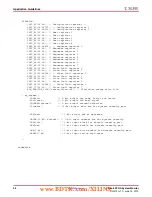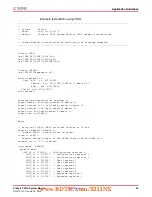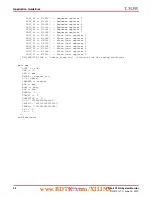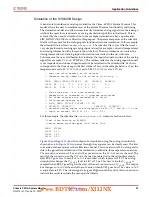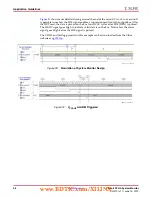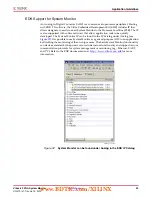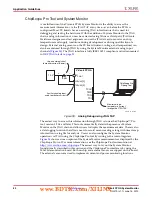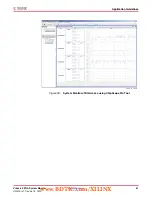
50
Virtex-6 FPGA System Monitor
UG370 (v1.1) June 14, 2010
Application Guidelines
SYSMON I/O
For this design the SYSMON I/Os listed in
are used.
X-Ref Target - Figure 29
Figure 29:
System Monitor Sample Design
DO[15:6]
DADDR[4:0]
DWE
RESET
DEN
CHANNEL[4:0]
DCLK
50 MHz
External Clock
ALM[2]
EOS
BUSY
SYSMON
DADDR[5]
DADDR[6]
0
0
0
0
clk
busy
alarm
V
CCAUX
[9:0]
10-Bit V
CCAUX
Measurement
(3 mV / LSB)
UG370_29_060809
Table 20:
SYSMON I/Os
Name
I/O
Description
DADDR[6:0]
Inputs
DRP address bus. The status registers (for example,
measurement results) are accessed via the DRP. In this sample
design, the CHANNEL[4:0] bus is connected to DADDR[4:0]
and DADDR[6:5] are connected to logic 0.
DEN
Input
DRP enable signal. When High, the address on DADDR[6:0]
is latched, and the contents of the corresponding register is
placed on the DO[15:0] bus. In this example, DEN is connect
to EOS.
DWE
Input
DRP write enable. Since no writes take place to the DRP, this
input is held at logic 0.
RESET
Input
SYSMON reset signal. It is tied to logic 0 in this example.
CHANNEL[4:0]
Output
ADC input multiplexer address. The ADC input multiplexer
address is placed on this bus at the end of the conversion
when BUSY transitions Low (refer to
). Because the results of input MUX address
02h
(V
CCAUX
) are placed in the status register at DRP address
02h
, these outputs can be used to drive the DADDR[6:0]
inputs to access the V
CCAUX
result.
EOS
Output
End-of-Sequence output. EOS pulses High for one DCLK
cycle at the end of a full channel sequence. In this example,
VCCAUX is the last channel in the sequence, allowing EOS to
be used as an input to DEN to latch the address on
DADDR[6:0] and enable the contents of Status register
02h
onto the DO bus for reading.
www.BDTIC.com/XILINX



















